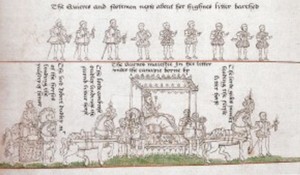 A friend of mine recently wrote to me to share some information he’d read about Anne Boleyn in a book by Trea Martyn, called Elizabeth in the Garden. The book tells the story of how two of the most powerful men in Elizabethan England (Dudley and Cecil) used garden designs to woo their queen.
A friend of mine recently wrote to me to share some information he’d read about Anne Boleyn in a book by Trea Martyn, called Elizabeth in the Garden. The book tells the story of how two of the most powerful men in Elizabethan England (Dudley and Cecil) used garden designs to woo their queen.
Here is the synopsis:
Taking a fresh and original approach to the life and reign of Queen Elizabeth I, this book tells the incredible story of her great passion for gardens, and how the two most powerful men in England during her reign fought a decade-long duel for their queen’s affections by creating lavish gardens for her. It chronicles how, in their quest to woo the queen and outdo each other, Robert Dudley, Earl of Leicester, and William Cecil, Baron of Burghley, competed for Elizabeth’s favor by laying out innovative and extravagant pleasure grounds at their palaces for when she came to visit. As she played one off against the other, they created gorgeous palaces and landscapes that amazed the world. The book also describes how others in England and abroad followed Dudley’s and Cecil’s leads and how the queen’s love of plants made gardeners of courtiers, statesmen, and soldiers. This meticulously researched account reveals how Elizabeth’s enthusiasm for horticulture changed the world, encouraging gardeners and designers to create landscapes inspired by the spirit of the Elizabethan garden.
What caught my friend’s attention, and subsequently mine, was a piece of information included in a discussion about Elizabeth’s coronation procession through London:
 “Extravagant sets had been built for the pageants, in which all of the parts were played by children. In the first pageant, a triumphal arch garlanded with roses towered over a three-tiered stage which stretched the width of the street. On the lowest level, there was the figure of Henry VII, in the center of a vast red rose, hand in hand with Elizabeth of York, inside a white rose, representing the union of the House of Lancaster with the House of York and the ending of the War of the Roses. On the next stage, Henry VIII and Anne Boleyn sat inside a giant Tudor rose. Two roses stretched up and above them, joining in a single stem to reach Elizabeth, enthroned at the top of the pyramid. It was the first time in nearly thirty years that Anne’s image had appeared in public. Her memory had until now brought disgrace- in the aftermath of her execution in 1536, Elizabeth had been exiled from court.” (Pg. 16)
“Extravagant sets had been built for the pageants, in which all of the parts were played by children. In the first pageant, a triumphal arch garlanded with roses towered over a three-tiered stage which stretched the width of the street. On the lowest level, there was the figure of Henry VII, in the center of a vast red rose, hand in hand with Elizabeth of York, inside a white rose, representing the union of the House of Lancaster with the House of York and the ending of the War of the Roses. On the next stage, Henry VIII and Anne Boleyn sat inside a giant Tudor rose. Two roses stretched up and above them, joining in a single stem to reach Elizabeth, enthroned at the top of the pyramid. It was the first time in nearly thirty years that Anne’s image had appeared in public. Her memory had until now brought disgrace- in the aftermath of her execution in 1536, Elizabeth had been exiled from court.” (Pg. 16)
I had never before heard about Anne Boleyn’s image being included in Elizabeth’s coronation. Since the author did not cite the source, I felt compelled to research it further by delving into some contemporary sources.
In the Diary of Henry Machyn, Citizen and Merchant-Taylor of London, from A.D 1550 to A.D. 1563, I found mention of Anne Boleyn. The original manuscript was damaged in a fire that consumed part of the Cottonian Library in 1731 and so the nineteenth –century editor was forced to make some emendations to the text, indicated in square brackets.
[The xiv day of January the Queen came in a chariot from] the Towre, with all the lordes and ladies [in crimson] velvet, and and ther horses trapyd with the sam, and [trumpeters in] red gownes blohyng, and all the haroldes in ther cottes armur, and all the strettes stroyd with gravell; and at Grasyus strett a goodly pagantt of kyng [Henry] the viij and quen Ane ys wyff and of ther lenege…
Machyn describes how at Gracechurch Street, Henry VIII and Anne Boleyn formed part of this pageant but he gives no further details.
I continued my search and found that a pamphlet describing every detail of Elizabeth’s royal entry, including the pageants, participants, poems and songs, had been published only a few days after Elizabeth’s ceremonial procession.
A fully annotated version of the pamphlet was published in The Queen’s Majesty’s Passage & Related Documents, edited with an introduction by Germaine Warkentin. This work is based on the only known copy of the first edition of the pamphlet and includes many wonderful illustrations and two maps.
The contemporary documents do indeed confirm that Anne Boleyn was included in the pageant on Gracechurch Street and for the first time in 23 years, acknowledged in public.
As related in the pamphlet, at the upper end of Gracechurch Street, just before a tavern known as the Spread Eagle, a stage was made that extended from one side of the street to the other. It was ‘richly vaulted with battlements containing three portes’ (doors) and over the middle of the stage, rising upwards, were three separate stages. On the lower stage was a throne,
‘wherein were placed two personages representing King Henry the seventh and Elizabeth his wife, daughter of King Edward the fourth, either of these two princes sitting under one cloth of estate in their seats, not otherwise divided, but that the one of them which was King Henry the seventh, proceeding out of the house of Lancaster, was enclosed in a red rose, and the other which was Queen Elizabeth, being heir to the house of York, enclosed with a white rose, each of them royall crowned and decently appareled as appertaineth to princes, with scepters in their hands, and one vault surmounting their heads, wherein aptly were placed two tables, each containing the title of those two princes. And these personages were so set that the one of them joined hands with the other, with the ring of matrimony perceived on the finger. Out of which two roses sprang, two branches gathered into one, which were directed upward to the second stage or degree wherein was placed one representing the valiant and noble prince King Henry the eighth, which sprang out of the former stock, crowned with a crown imperial, and by him sat one representing the right worthy Lady Queen Anne, wife to the said King Henry the eighth and mother to our most sovereign Lady Queen Elizabeth that now is, both apparelled with scepters and diadems and other furniture due to the estate of a king and queen, and two tables surmounting their heads wherein were written their names and titles. From their seat also proceeded upwards one branch directed to the third and uppermost stage or degree, wherein likewise was planted a royal seat, in which was set one representing the Queen’s most excellent Majesty Elizabeth now our most dread sovereign Lady, crowned and apparelled as the other princes were.’ (Warkentin, Pg. 78-79)
As Elizabeth approached, a small child standing on a platform, ‘declared unto her the whole meaning of the pageant.’
The pageant was covered in sayings and mottoes concerning unity, decorated with red and white roses and ‘grounded upon the Queen’s Majesty’s name’.
As Germaine Warkentin notes, it explained Elizabeth’s title to the crown of England ‘but the prudent inclusion of the executed Anne Boleyn was a marked change from the time not long past when Anne had been a rejected consort and her daughter declared a bastard’ (Pg. 57).
Details of Elizabeth’s procession also appear in a report made by Aloisio Schivenoglia to Sabino Calandra, Castellan of Mantua, on January 23 1559.
Schivenoglia was an Italian in the service of Sir Thomas Tresham, Prior of the Order of St. John of Jerusalem in England. In his report of the royal entry he states:
“Her majesty then set off, and first passed the piazza of the Tower. The artillery began to fire, which went on for half an hour until her Majesty arrived at Gracechurch Street, where the Londoners had raised the first triumphal arch, which was very lofty, divided into three levels. On the first were King Henry VII, of the House of Lancaster, with a large white rose in front of him, and Queen Elizabeth his wife, of the House of York, with a similar large rose in front of her, but red [both] in royal robes. On the second level above there were seated King Henry VIII, with a similar rose in front of him, but white and red, [then] a pomegranate in the middle, and Queen Anne Boleyn, mother of this Queen, with a white eagle and a gold crown on its head and gilt scepter in its right talon, the other resting on a little hill, and surrounded by small branches with little roses in front, the coat of arms and device of the said Queen. Further up on the third [level] sat a Queen in majesty to represent the present one, who is descended from the aforesaid. Outside, and higher still on the facade were the royal arms of England, trophies, festoons, etc. with columns, capitals and bases, etc.”
(Warkentin, Pg. 107)
Warkentin notes that a pomegranate was a symbol of the Resurrection because of the association with the myth of Persephone. He continues, ‘in the Renaissance it was widely used in the impresas of rulers because its many seeds within a single shell made it a figure of unified authority’ (Pg. 79).
There would have been those watching Elizabeth’s procession that could recall four other such events that had taken place in the last 26 years. Anne Boleyn’s coronation procession in 1533; Edward VI in 1547; and two by Queen Mary, first upon her own accession in 1553 and with her new husband, Philip of Spain, in 1554.
This was of course not the first time that Elizabeth had processed through the city of London. In 1533, as tradition dictated, her mother had gone in procession from the Tower of London to Westminster and on the corner of Fenchurch and Gracechurch Street had stopped to admire a tableau designed by Holbein. The Latin verses made the meaning crystal clear,
Anna comes, the most famous woman in all the world,
Anna comes, the shining incarnation of chastity,
In snow white litter, just like the goddesses,
Anna the queen is here, the preservation of your future.
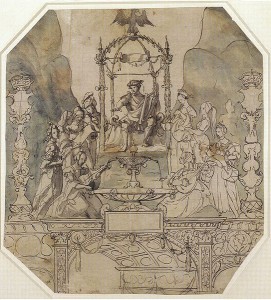
Apollo and the Muses on Parnassus. Holbein’s design for a street tableau for the coronation procession of Anne Boleyn.
Anne Boleyn was pregnant with the heir to the Tudor throne but it was not the longed for prince, rather an auburn-haired girl by the name of Elizabeth.
The inclusion of Anne Boleyn in Elizabeth’s coronation procession was a very powerful show of loyalty on Elizabeth’s part. Although Elizabeth was not officially responsible for the design of the pageants, Warkentin asserts that ‘it is almost inconceivable that she had not seen at least the ‘plat’ (scenario) of the entry’ and goes on to state that no one at court was surprised on the day – least of all the Queen (Pg. 35).
William Cecil worked closely with those that designed the queen’s entry and surely would not have permitted anything that he knew would not meet with the queen’s approval.
At various times during Elizabeth’s early life, when the odds were stacked against her, she must have wondered whether she would ever become queen. So to have her mother, Anne Boleyn, acknowledged publicly on one of the most important days of her life, shows the deep affection she bore for her.
If ever there were any doubts about what Elizabeth felt for Anne Boleyn, surely they are now put to rest.
References ‘Diary: 1559 (Jan – Jun)’, The Diary of Henry Machyn: Citizen and Merchant-Taylor of London (1550-1563) (1848), pp. 184-201. URL: http://www.british-history.ac.uk/report.aspx?compid=45523&strquery=Anne+Boleyn Date accessed: 10 August 2012. Martyn, T. Elizabeth in the Garden, 2012. Warkentin, G. (Ed.). The Queen’s Majesty’s Passage & Related Documents. 2004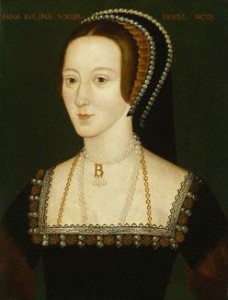
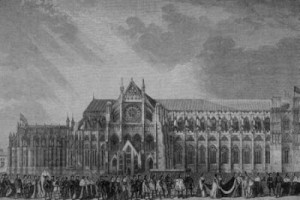
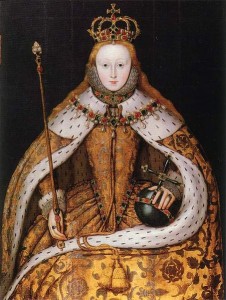

















Thanks for sharing this fantastic research! It’s so rewarding when one small thread can lead to an entire meaningful archive.
I am so glad that you enjoyed it Miranda! Thank you for taking the time to comment. Natalie
I really enjoyed this piece. Elizabeth affection for her mother was often quite subtlety displayed and we are left wondering what she made of her mothers fall from grace but this really does show her support for her memory . I suppose she had to tread carefully between her admiration for her father as a powerful king and her love for a mother she barely knew.What a difficult path she had to the throne, no wonder she wanted a coronation to remember
Thank you. This is very infomotive. Enjoyed it
I’m glad Jacky, thanks for dropping by!
Anne wore a double locket ring with a picture of her on one side and her mother on the other. When she died the ring was imbedded in her finger and they had to pry it off. Her wearing this ring most of her life shows to me she had great esteem for her mother. The ring can be viewed at Checquers, however, I think it should be amidst the royal jewels.
Throughout Elizabeth’s reign she wore a locket ring with a portrait of her mother on one side and herself on the other. I think this shows that she had high esteem for her mother. She never took it off. It apparently imbedded itself in her finger and when she died it had to pried from her finger to be sent to James I. The wearing of this ring (now housed at ( Checquers), proves she had high regard for her mother. There is no ring found of her and her father. I think she was duly frightened of him.
How on earth could she have loved her father after what he did ! I think she was frightened of him ! What an incredible women Elizebeth was a loss of a mother at that age is devastating but in the manner that Ann died must have been dreadful .i believe this is what made her the women she became and the best monache this country ever had !She was still proud of her mother and held her dear to her heart and so she should Ann was incredible women as well !!!
In her book Anne Boleyn (1972) Marie-Louise Bruce describes how “her (Elizabeth’s) mother’s image smiled down from a pageant at Gracechurch. . . . (there,) restored to her place next to Henry VIII in the middle, (was) Anne Boleyn” (p. 335). Bruce also tells the familiar story of Scottish reformer Alexander Aless writing to Elizabeth of his nightmare in the early morning hours of May 19, 1536, of Queen Anne beheaded. (Aless had been ill and confined to his home and so had no idea what was to happen later that day.) Deeply disturbed, Aless had then gone for a walk and had run into Thomas Cranmer. Aless described his dream, and Cranmer told him, “She who has been the Queen of England on earth will today become a Queen in Heaven!” Cranmer then burst into tears. Though Elizabeth made no official reply, she must have been interested since she kept Aless’ letter!
It is comforting to know that Elizabeth was able to be publicly proud of her mother. I had read about her mother’s portrait in the locket ring that she wore. This public street display of Anne in her lineage shows the love and approval that the citizens of London had for their new queen Elizabeth. Now if DNA tests could be performed on the headless bodies in the burial floor of the chapel in the Tower of London, we might know if that remains Anne’s final resting place.
Tremendous site and information. wonderful. Many thanks to you for all of your hard work and research.
I have only read about 2 accounts on Elizabeth I and her mother Queen Anne, you can say “wow only two?” but in accordance to what happened I believe that its remarkable that those two accounts even exists!! I cannot imagine the pain she went through. I would be terrified of Henry VIII I mean almost 500 years later and I’m still frightened by him!! I hope Anne watched from heaven and I hope she was the first to greet Elizabeth when she entered the Kingdom of Heaven herself… may both Queens rest in peace together!